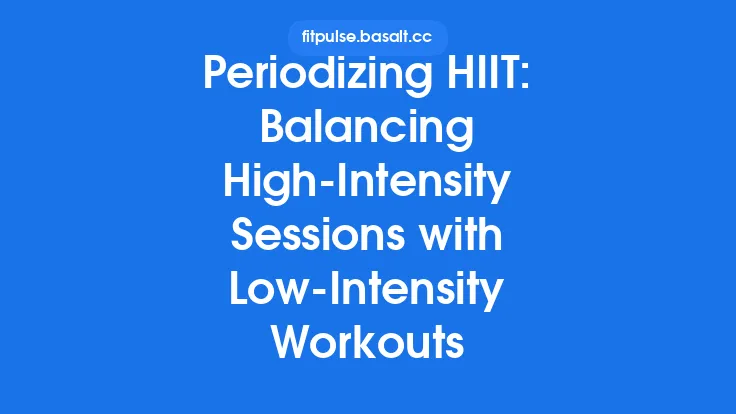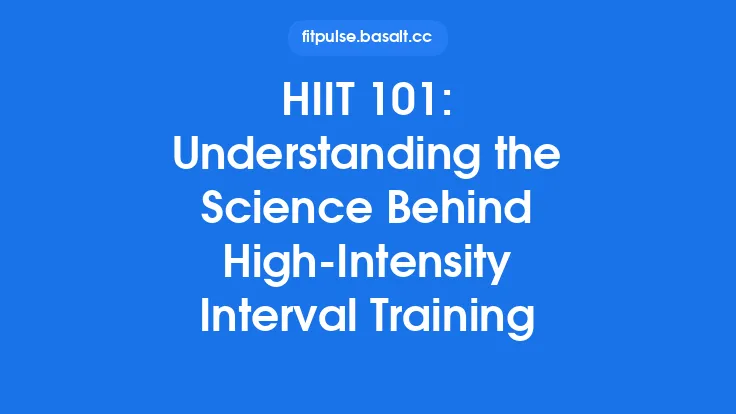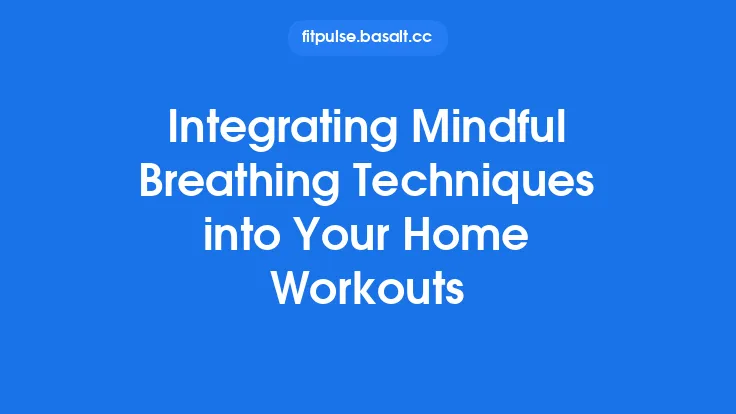High‑intensity interval training (HIIT) has become a staple of home‑based fitness because it delivers cardiovascular and metabolic benefits in a short amount of time. Yet the very nature of HIIT—brief, maximal bursts of effort followed by rapid recovery—can also trigger a heightened stress response, especially for those who are new to intense work or who train without a structured breathing plan. The 4‑7‑8 breathing method, a simple yet powerful technique rooted in controlled exhalation, offers a practical way to temper that stress while preserving the performance gains of HIIT. By deliberately syncing the inhale‑hold‑exhale pattern with the work‑rest structure of interval sessions, athletes can improve oxygen utilization, stabilize heart‑rate variability, and maintain mental focus throughout the workout. The following guide explores the science behind the method, outlines step‑by‑step integration strategies, and provides concrete workout templates that you can implement in any home environment.
Understanding the 4‑7‑8 Breathing Method
The 4‑7‑8 technique consists of three phases:
- Inhale through the nose for a count of four seconds, filling the lower lungs first and then expanding the rib cage.
- Hold the breath for seven seconds. This pause allows for a brief equilibration of oxygen and carbon dioxide levels in the bloodstream.
- Exhale slowly and completely through the mouth for eight seconds, creating a gentle resistance that engages the diaphragm and abdominal muscles.
The ratio (4:7:8) is deliberately longer on the exhalation, which activates the parasympathetic branch of the autonomic nervous system (the “rest‑and‑digest” response). Over repeated cycles, this pattern can lower resting heart rate, reduce cortisol spikes, and improve overall respiratory efficiency.
Why Pair 4‑7‑8 with High‑Intensity Interval Training?
HIIT’s alternating structure—typically 20–60 seconds of maximal effort followed by 10–30 seconds of recovery—mirrors the rhythmic nature of controlled breathing. When the breath is left to the default, often shallow, pattern that accompanies intense effort, the body may experience:
- Elevated sympathetic drive (increased adrenaline and heart‑rate).
- Rapid, shallow breathing that limits oxygen exchange.
- Early onset of perceived exertion, leading to premature fatigue.
By inserting the 4‑7‑8 cycle into the recovery phases, you deliberately shift the autonomic balance toward parasympathetic dominance, which:
- Accelerates lactate clearance by improving blood flow and oxygen delivery.
- Stabilizes heart‑rate variability (HRV), a marker of cardiovascular resilience.
- Enhances mental clarity, allowing you to maintain proper form during subsequent work intervals.
Physiological Mechanisms at Play
| Mechanism | How 4‑7‑8 Influences It | Relevance to HIIT |
|---|---|---|
| Ventilatory Efficiency | Longer exhalation increases tidal volume and reduces dead‑space ventilation. | More oxygen per breath during high demand. |
| Baroreceptor Reflex | Slow exhalation raises intrathoracic pressure, momentarily lowering systolic pressure and prompting a reflexive heart‑rate reduction. | Faster heart‑rate recovery between sprints. |
| Diaphragmatic Activation | The hold phase forces the diaphragm to stay engaged, strengthening its contractile endurance. | Better core stability during explosive movements. |
| Cortisol Modulation | Parasympathetic activation blunts the hypothalamic‑pituitary‑adrenal (HPA) axis response. | Reduced stress perception, less mental fatigue. |
Integrating 4‑7‑8 into HIIT Workflows
- Identify the Recovery Window
Most HIIT protocols allocate 10–30 seconds for rest. Reserve 15–20 seconds of that window for the 4‑7‑8 cycle. If the rest period is shorter, you can truncate the hold to 5 seconds while preserving the 4:5:6 ratio (inhale‑hold‑exhale) to maintain the exhalation emphasis.
- Pre‑Workout Primer
Before the first work interval, perform two full 4‑7‑8 cycles while standing or seated. This primes the nervous system and establishes a breathing rhythm.
- Cue Placement
- During Work: Focus on a natural, rhythmic breath (e.g., 2‑2 pattern for a 30‑second sprint). Avoid forced 4‑7‑8 during high‑intensity bursts; the goal is to keep breathing efficient, not restrictive.
- During Rest: Immediately after the work phase, transition to the 4‑7‑8 pattern. Use a timer or a simple verbal cue (“inhale 4, hold 7, exhale 8”) to guide the transition.
- Progressive Adaptation
Start with one 4‑7‑8 cycle per rest and gradually increase to two cycles as your lung capacity and comfort improve. For longer HIIT sessions (e.g., 30‑minute protocols), you can incorporate a full 4‑7‑8 set after every four work intervals to provide a deeper recovery.
Sample HIIT Routines with Breathing Cues
Routine A: Body‑Weight Circuit (20 min)
| Interval | Exercise (seconds) | Breathing Focus |
|---|---|---|
| Warm‑up | Light jogging in place – 3 min | Natural diaphragmatic breathing |
| 1 | Jump squats – 30 s | 2‑2 inhale/exhale pattern |
| Rest | 4‑7‑8 breathing – 20 s (full cycle) | 4‑7‑8 |
| 2 | Push‑ups – 30 s | 2‑2 |
| Rest | 4‑7‑8 breathing – 20 s | 4‑7‑8 |
| 3 | Mountain climbers – 30 s | 2‑2 |
| Rest | 4‑7‑8 breathing – 20 s | 4‑7‑8 |
| 4 | Plank shoulder taps – 30 s | 2‑2 |
| Rest | 4‑7‑8 breathing – 20 s | 4‑7‑8 |
| Repeat the block 4 times | ||
| Cool‑down | Stretch & deep breathing – 3 min | Natural, relaxed breathing |
Routine B: Cardio‑Focused HIIT (15 min)
| Interval | Exercise (seconds) | Breathing Focus |
|---|---|---|
| Warm‑up | Jump rope – 2 min | Natural |
| 1 | Sprint in place – 20 s | 2‑2 |
| Rest | 4‑7‑8 breathing – 15 s (partial cycle) | 4‑5‑6 (shortened) |
| 2 | High knees – 20 s | 2‑2 |
| Rest | 4‑7‑8 breathing – 15 s | 4‑5‑6 |
| 3 | Burpees – 20 s | 2‑2 |
| Rest | 4‑7‑8 breathing – 15 s | 4‑5‑6 |
| Repeat the set 5 times | ||
| Cool‑down | Walking & gentle breathing – 3 min | Natural |
Adapting the Technique for Different Fitness Levels
| Fitness Level | Recommended Inhale/Exhale Count | Hold Duration | Rest Period Allocation |
|---|---|---|---|
| Beginner | 3 seconds inhale, 4 seconds exhale | 4 seconds | Use 10‑second rest; perform a single 3‑4‑4 cycle |
| Intermediate | Standard 4‑7‑8 | 7 seconds | 15‑second rest; full 4‑7‑8 cycle |
| Advanced | 5‑8‑9 (slightly longer exhale) | 8 seconds | 20‑second rest; two consecutive cycles per rest |
For individuals with respiratory limitations (e.g., mild asthma), the hold phase can be reduced to 3–5 seconds while preserving the longer exhalation. This still yields parasympathetic activation without over‑taxing the airway.
Common Pitfalls and How to Avoid Them
- Rushing the Exhale – A hurried exhalation defeats the purpose of vagal stimulation. Practice the “whoosh” sound on the exhale to maintain a steady flow.
- Holding Breath During Work – Attempting a 4‑7‑8 pattern while sprinting or performing explosive moves can cause oxygen debt and dizziness. Keep the work‑phase breathing natural and reserve the technique for recovery.
- Skipping the Hold – The 7‑second pause is crucial for CO₂ tolerance. If you find it uncomfortable, start with a 5‑second hold and incrementally increase.
- Inconsistent Timing – Use a simple timer app or a metronome set to 60 bpm; count “1‑2‑3‑4” for inhale, “1‑2‑3‑4‑5‑6‑7” for hold, and “1‑2‑3‑4‑5‑6‑7‑8” for exhale.
Monitoring Progress and Adjusting Variables
- Heart‑Rate Variability (HRV): Track HRV each morning using a chest strap or wrist sensor. An upward trend indicates improved parasympathetic tone, suggesting the breathing integration is effective.
- Perceived Exertion (RPE): Record RPE after each HIIT session. A decreasing RPE for the same work interval signals better oxygen efficiency.
- Lactate Threshold Tests: If you have access to a lactate meter, measure blood lactate after a standard HIIT set. A lower post‑exercise lactate level over weeks reflects enhanced clearance, often linked to improved breathing patterns.
- Breath‑Hold Duration: Periodically test how long you can comfortably hold after a full inhale. Incremental improvements (e.g., from 7 seconds to 9 seconds) indicate increased CO₂ tolerance and diaphragmatic strength.
When progress plateaus, consider:
- Extending the exhalation (e.g., 4‑7‑9) to deepen parasympathetic activation.
- Increasing the number of cycles per rest period.
- Adding a brief “post‑HIIT” 4‑7‑8 session (2–3 minutes) to consolidate recovery.
Safety Considerations and Contraindications
- Hypertension: Individuals with uncontrolled high blood pressure should consult a healthcare professional before adopting prolonged breath‑holds.
- Vertigo or Inner‑Ear Disorders: The hold phase can provoke dizziness; start with a shorter hold and monitor symptoms.
- Pregnancy: The 4‑7‑8 method is generally safe, but pregnant exercisers should avoid deep breath‑holds that increase intra‑abdominal pressure; a 4‑4‑6 pattern is recommended.
- Severe Cardiopulmonary Conditions: Those with chronic obstructive pulmonary disease (COPD) or recent cardiac events should use a modified, shorter exhalation and avoid the hold phase unless cleared by a physician.
Always begin each session with a brief warm‑up and end with a cool‑down that includes natural breathing to transition smoothly between autonomic states.
Frequently Asked Questions
Q: Can I use 4‑7‑8 while doing resistance training?
A: Yes, but limit the technique to the rest intervals between sets. During the lift itself, maintain a natural, controlled breath (inhale during eccentric phase, exhale during concentric phase) to preserve intra‑abdominal pressure.
Q: How many 4‑7‑8 cycles should I aim for per workout?
A: For a typical 20‑minute HIIT session, 8–12 full cycles (one per rest) provide a balanced stimulus. Advanced athletes may incorporate 2 cycles per rest for a total of 16–24 cycles.
Q: Will this method replace the need for a cool‑down?
A: No. The 4‑7‑8 technique accelerates parasympathetic activation, but a dedicated cool‑down with gentle movement and stretching still aids in metabolite clearance and joint mobility.
Q: Is it okay to practice 4‑7‑8 while seated or lying down before a HIIT session?
A: Absolutely. A brief pre‑session practice (2–3 cycles) can prime the nervous system, especially on days when you feel particularly stressed or fatigued.
Q: Does the method improve VO₂ max?
A: Direct improvements in VO₂ max stem from the high‑intensity work itself. However, by enhancing breathing efficiency and recovery speed, 4‑7‑8 can indirectly support higher training volumes, which over time may contribute to VO₂ max gains.
Final Thoughts
Integrating the 4‑7‑8 breathing method into high‑intensity interval sessions bridges the gap between performance and stress management. By deliberately allocating recovery time to a structured inhale‑hold‑exhale pattern, you harness the body’s innate autonomic mechanisms to lower heart rate, improve oxygen exchange, and reduce cortisol spikes—all without sacrificing the calorie‑burning and cardiovascular benefits that make HIIT so effective.
Start modestly: practice two cycles during the first rest period of a simple body‑weight circuit, monitor how your heart rate and perceived effort respond, and gradually expand the technique as your comfort grows. With consistent application, the 4‑7‑8 method becomes a seamless, invisible partner that supports both the mind and the muscles, turning every home‑based HIIT workout into a more balanced, resilient, and enjoyable experience.





